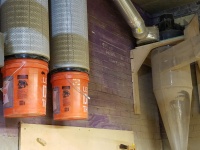Difference between revisions of "Dust Collection"
m (fix link to woodcentral.com) |
|||
| Line 1: | Line 1: | ||
| + | {{Template:Equipment | ||
| + | |owner=LVL1 | ||
| + | |serial=NA | ||
| + | |model=dust collector | ||
| + | |arrived=2016 | ||
| + | |doesitwork= yes | ||
| + | |contact= Paul G.!!! | ||
| + | |where=wood shop | ||
| + | |picture= dust collector.jpg | ||
| + | }} | ||
| + | |||
== Purpose == | == Purpose == | ||
Revision as of 17:42, 12 January 2019
[Equipment|Back to list of Equipment]]

|
Contents
General
|
Purpose
- Breathing wood dust is a health hazard
- Wood dust build-up around the shop is a fire hazard
- The dust collection system protects our people and equipment by removing wood chips and dust (down to 0.5 micron diameter) from the shop environment
Operation
Safety Rules
- Hot embers falling into dust collection bins are the #1 cause of fires in dust collection systems, so:
- NEVER NEVER NEVER NEVER cut metal (including nails, screws, staples in wood pieces) on any tool that is connected to the dust collector
- If a cutting tool is burning wood, slow down or replace with a sharper tool
- Empty the cyclone’s collection drum into outdoor garbage cans nightly
- Wear a dust mask when emptying the dust collection drum and buckets
Maintenance
Cleaning the Filters
- Cleaning frequency depends on filter pressure drop, which we aren’t measuring yet. Expect monthly or quarterly cleaning frequency
- Filters are cleaned by blowing compressed air from the outside to dislodge the dust cake on the inside, waiting to let dust settle into orange buckets under the filters, then unscrewing the buckets to empty the dust.
- Wear a dust mask to open and empty the buckets
Design Basis
This system follows design guidance on Bill Pentz’s dust collection website.
Most dust collection hardware is designed to capture only larger wood chips and sawdust, but fine dust is the most dangerous to human health and most easily propagates fires. Bill Pentz's dust collection designs and recommendations deal with collecting fine dust. This system uses higher air flows, a more efficient cyclone, and finer filters than are found in most off-the-shelf dust collectors.
Air Flow
- air flow target is 850 CFM at the tool, which is enough to capture fine dust that is generated
- minimum air velocity in ducts is 4000 FPM, which is needed to move dust up vertical rises and to keep dust collecting in ducts
- blower has a 2 hp motor and 12 inch impeller
- Two Wynn Environmental 9L300NANO filters supply 600 sq.ft. filtration media. Expectation is 99.99% filtration of particle bigger than 0.5 micron diameter once filters are conditioned (meaning once a cake of fine dust is built up inside the filter).
Gates
This system will support collecting dust from one tool at a time. Gates must be installed and used to route flow to the tool that is being used and to block air flow from all other tools. Some starter design resources for gates:
Tool Hoods
- Hooking a hose up to the off-the-shelf wood chip collection port on most tools is not sufficient for fine dust collection
- Installing a port that is too small restricts airflow. This creates a fire hazard by allowing dust to build up in the ducting
- Lots of designs and guidance on Bill Pentz's tool ports and hoods page
- Hack on!
CNC Dust Skirt Guidance
- The current (Nov 2017) CNC dust skirt restricts airflow too much for safe and adequate dust collection
- minimum cross-sectional area of the skirt air channel opening must be 20 sq inches
- flex hose form the skirt to the ceiling ducts must be 6" diameter. Smaller diameter will choke flow below 4000 FPM needed to transport dust to the ceiling
- gerg on instructables.com has an upgraded skirt design with instructions and DXF files.
- Here's a design for the flex hose that uses a vertical rise of rigid 6” PVC pipe to clear the CNC gantry, then 6” flex hose to ducts in the ceiling. The video shows a motion test of his flex hose suspension layout.
Static Discharge from PVC Ducting
- is not considered a fire hazard for small woodshops
- but is very uncomfortable for humans and fatal to thumb drives full of Shopbot files
- Bill Pentz’s static electricity section recommends 2" aluminum tape to bleed static
- Joints in our dust collector are made by first putting a band of 2" aluminum tape around the duct, then drilling 1/2" sheet metal screws through the joint to pierce the inner duct wall and stick into the airflow. Grounding the tape and screws provides a path to bleed some static from the flowing wood dust stream.
Upgrade Path
The system has an upgrade path to support 2 tools simultaneously. This would involve installing a 5hp motor and a larger impeller available from Clear Vue Cyclones for 1800 CFM design flow. It would also require some ducting changes, starting with installing an 8" header that the 6" line branch out from.
